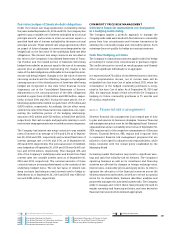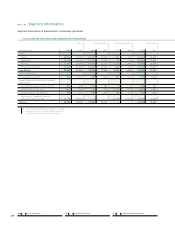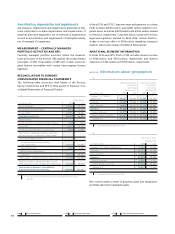Siemens 2014 Annual Report Download - page 304
Download and view the complete annual report
Please find page 304 of the 2014 Siemens annual report below. You can navigate through the pages in the report by either clicking on the pages listed below, or by using the keyword search tool below to find specific information within the annual report.
108 A. To our Shareholders 131 B. Corporate Governance 171 C. Combined Management Report
The aggregated commodity price risk exposure is hedged
with external counterparties through derivative financial hedg-
ing instruments by Corporate Treasury. Derivative financial
hedging instruments designated for hedge accounting are
directly entered into with external counterparties. Additionally,
Siemens applies a Company-wide portfolio approach which
optimizes the Company’s position of the overall financial com-
modity price risk.
Using historical volatilities and correlations, a ten day holding
period and a confidence level of . %, the VaR, which com-
prises the net position of commodity derivatives and the com-
modity purchase transactions with price risk, was € million
as of September , compared to € million as of Septem-
ber , . The prior-year amount has been adjusted in order
to take into consideration modified principles with regard to
commodity price risk management.
EQUITY PRICE RISK
Siemens’ investment portfolio consists of direct and indirect
investments in publicly traded companies held for purposes
other than trading. The direct participations result mainly from
strategic partnerships, strengthening Siemens’ focus on its core
business activities or compensation from M & A trans actions;
indirect investments in fund shares are mainly transacted for
financial reasons.
These investments are monitored based on their current
market value, affected primarily by fluctuations in the volatile
technology-related markets worldwide. The market value of
Siemens’ portfolio in publicly traded companies decreased from
€ , million as of September , to € , million as of
September , .
Based on historical volatilities and correlations, a ten day hold-
ing period and a confidence level of . %, the VaR as of Sep-
tember , of Siemens’ equity investments was € mil-
lion compared to € million the year before.
LIQUIDITY RISK
Liquidity risk results from the Company’s potential inability to
meet its financial liabilities, e.g. for the settlement of its finan-
cial debt or for ongoing cash requirements from operating and
SFS financing activities, dividend payments, pension plan fund-
ing and portfolio activities. In addition to having implemented
effective working capital and cash management, Siemens miti-
gates liquidity risk by arranged credit facilities with highly
rated financial institutions, via a debt issuance program and via
a global multi-currency commercial paper program. Liquidity
risk may also be mitigated by the Siemens Bank GmbH, which
increases the flexibility of depositing cash or refinancing by
using European Central Bank accounts.
In addition to the above-mentioned sources of liquidity,
Siemens constantly monitors funding options available in the
capital markets, as well as trends in the availability and costs of
such funding, with a view to maintaining financial flexibility
and limiting repayment risks.
The following table reflects all contractually fixed pay-offs for
settlement, repayments and interest resulting from recognized
financial liabilities as well as from credit guarantees and irrevo-
cable loan commitments. It includes expected net cash out-
flows from derivative financial liabilities that are in place as per
September , . Such expected net cash outflows are de-
termined based on each particular settlement date of an instru-
ment. The amounts disclosed are undiscounted net cash out-
flows for the respective upcoming fiscal years, based on the
earliest date on which Siemens could be required to pay. Cash
outflows for financial liabilities (including interest) without
fixed amount or timing are based on the conditions existing at
September , .
Year ended September ,
to
and
thereafter
(in millions of €)
Non-derivative financial
liabilities
Notes and bonds 649 2,911 9,361 8,383
Loans from banks 834 133 843 9
Other financial
indebtedness 828 9 45 33
Obligations under
finance leases 27 49 34 97
Trade payables 7,697 16 18 1
Other financial liabilities 1,014 65 432 8
Derivative financial liabilities 933 278 487 56
Credit guarantees 774 – – –
Irrevocable loan
commitments 3,214 215 174 1
The risk implied from the values shown in the table above
reflects the one-sided scenario of cash outflows only. Obliga-
tions under finance leases, trade payables and other financial
liabilities mainly originate from the financing of assets used in
Siemens’ ongoing operations such as property, plant, equip-
ment and investments in working capital – e.g. inventories
and trade receivables. These assets are considered in the
Company’s overall liquidity risk management. A considerable
portion of the irrevocable loan commitments result from asset-
based lending transactions meaning that the respective loans
can only be drawn after sufficient collateral has been provided
by the borrower. The amounts included for credit guarantees
























